Gibb’s Reflection Cycle
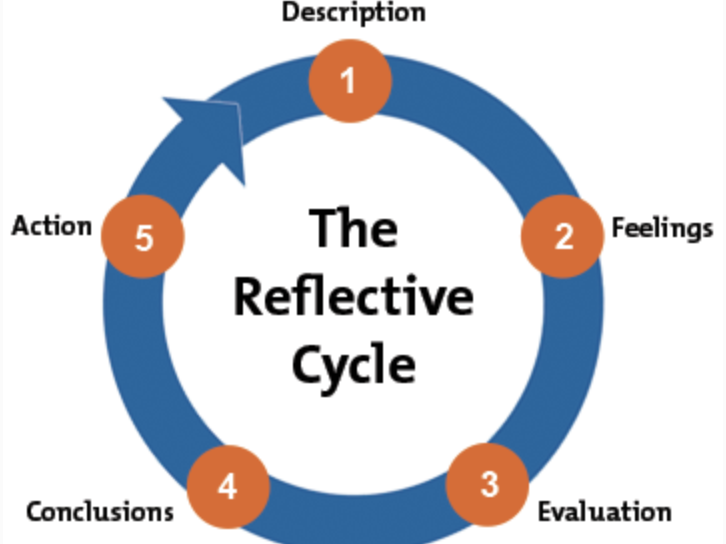
This week marks the final week I have left on writing the music before submitting it for the showcase, there are only three things I must complete in terms of my practical work. These things are; writing the music for the cinematic, writing music for the credits screen and refining weak points that I have in the music (timpani rhythm, dynamics, ect.) Below you can find the initial idea I had for the music of the credits screen I had. For this evaluation I will be using the gib’s reflection cycle to help me deliver and detailed and structured project evaluation.
This week I began to compose music for the end credits screen of the gameplay footage. At the end of the game before the credits roll the evil boss appears on screen, to reflect on this I wanted the main boss motif from the music to play during the credits to reflect on the presence of evil. To make the music seem more ambient as the credits roll I also slowed down the boss theme and isolated the choir motif. This however sounded very creepy and serious, furthermore making it sound as if it belonged to a horror movie such as Annabelle or the Conjuring. Therefore making the boss motif unsuccessful as it sounded too serious for the polygraphic and magical themed game I was composing for. To solve this issue I decided to compose another piece of music for the credits of the video game, for this next piece of music I wanted to compose a dark motif which however had a more playful and less serious tone.

The next idea I had for the credits theme was to bring back the harp motif from the very beginning of the composition, I did this because this motif had a very dark and minor tone. However it’s floating arpeggio created a playful and less serious tone in the music, therefore making it perfect for the end credits sequence. This worked very successfully as end credits music as not only did it match the tone I wanted for the game, but it also created a nostalgic theme within the music as the composition began and ended the same way. At this point I was happy with how the musical motif sounded, however the music ended very abruptly after the track had ended. This is because the music had no reverb or chord resolution, the solution to this issue would be to add one of the two of these musical techniques or to fade the music out. I decided to make the credit music fade out, this decision was inspired by the ‘Cave Scape’ soundtrack which ends the same way. The musical fade out worked very well as it brought the music to a natural and relaxed musical conclusion, which reflected on the end of the Journey which took place on screen. In conclusion the music for the end of the credits was also successful as it brought a nostalgic and dark tone which to the music which reflected on the narrative of the story within the game.
New Timpani Rhythm
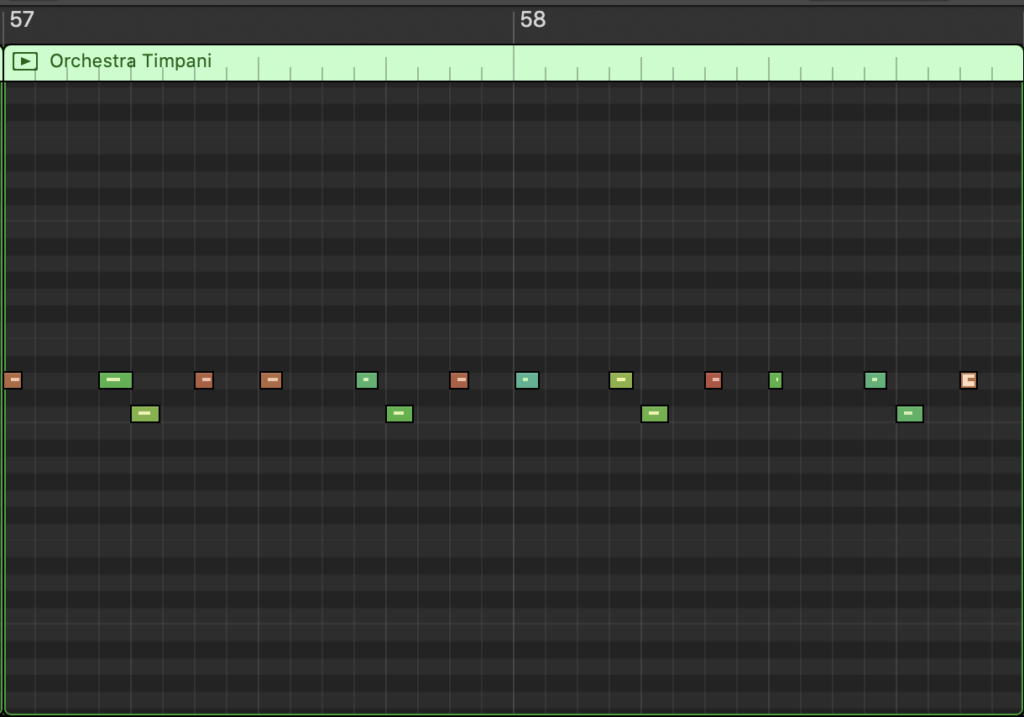
Last week I stated that the timpani rhythm was very boring and that I hoped to improve it in the upcoming week, this week I acted upon my reflection and made this happen. To do this I played along the boss theme on a loop and improvised different rhythms, my final rhythmic idea can be seen above. This rhythm is made up of the timpani which sometimes play off time with the other instruments in the arrangement, this created an unpredictable source of rhythmic tension within the music. I did this to reflect on the thrill of the combat and it’s unpredictable results (player may die or not). I also used the velocity tool to accent random beats within the music, which furthermore reinforced the unpredictable theme of the music. This was very successful as the timpani’s faster rhythm reflected on the fast paced combat while the off beat rhythm created an unsettling and unpredictable musical theme.
Final Cinematic Music (Triumphant)
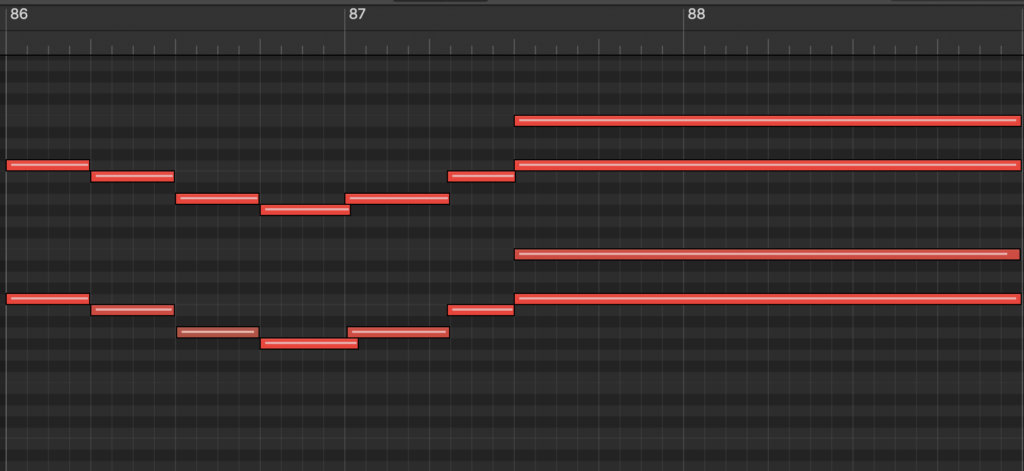
After composing the main boss theme I wanted the music to naturally blend into the next section of music, where I plan to conclude the composition in the final cinematic for the video game. The final note of the boss theme ends on a C, therefore I experimented with what chord I could resolve on by trying the chords; F major, C major and A minor. I chose these three chords as the note of C exists within all of these chords, therefore there is potential to resolve the boss theme in all of these chords. However resolving the boss theme on A minor sounded too dark and sad, as in the final cinematic I wanted the music to sound victorious as the final boss is defeated and the evil is destroyed. I also tried F major, however this did not work as the chord had too much tension, due to the C note from the melody belonging to the top of the chord. The final and successful chord I tried was C major, this was successful as the harmony and melody resolved very well and calmed down the music from the fast paced boss theme. Furthermore allowing me to naturally lead the music into the final section of music. Another reason I chose to use C major is because it had a very happy and joyful tone, which reflected on the relief the character in the game get’s from destroying the final boss in the battle.
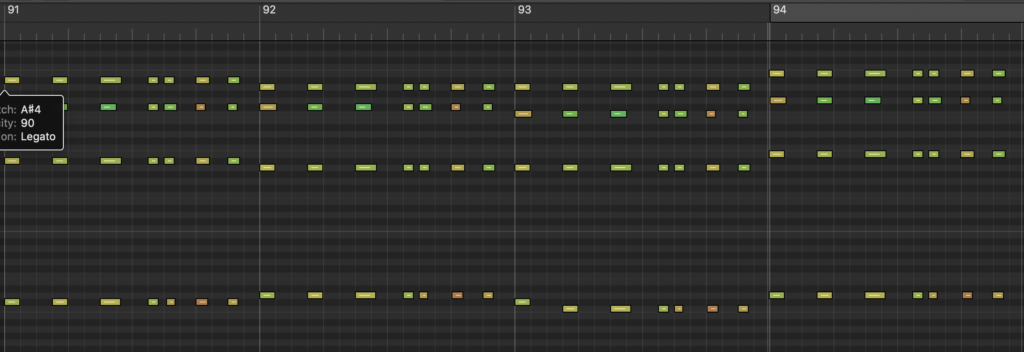
In the final cinematic for the game I wanted the music to initially sound triumphant as the player/character believe they have vanquished the evil. However later on in the cinematic we discover, that the evil has only been set free, therefore for this part in the music I wanted the music to transition from being in a happy triumphant key to a dark and foreboding key. To compose my musical idea I started with making a triumphant harmony that builds up in tension towards a climax, this harmony is played by the strings in a staccato articulation. To compose a triumphant chord progression I experimented with jumping between different major and minor chords, and moving up in the key to build tension in the music. The chord progression I composed was; F#, D, F augmented, and G. I used voice leading in the harmony to make the music flow more naturally between the chord transitions, while composing the staccato harmony I also made the strings play an upbeat rhythm, which reflected on the happiness and relief the player gets by thinking the boss is defeated. Composing these strings was very successful as it created a happy and triumphant tone within the music due to the harmonic arrangement, and the upbeat rhythm also gave the music an energetic tone. Furthermore convincing the player into thinking the boss is defeated, the augmented chord in the harmony also accurately foreshadows the resurrection of the boss as it creates a sense of mystery and uncertainty within the music.

This is a harp arpeggio I wrote for the triumphant section of the music within for the final scene of the video game. I wrote this harp in the music to play a fast paced arpeggio to give the music rhythmic excitement, furthermore creating a joyful tone within the music. The pitch of this instrumental is also raising in pitch, furthermore building up anticipation in the music towards the climax of the music, where I plan for the music to change into a minor key to reflect on the evil presence returning to the game. This harp instrumental was very successful as it helped create a joyful build up of anticipation, which smoothly builds the music up to the climax of the triumphant theme.
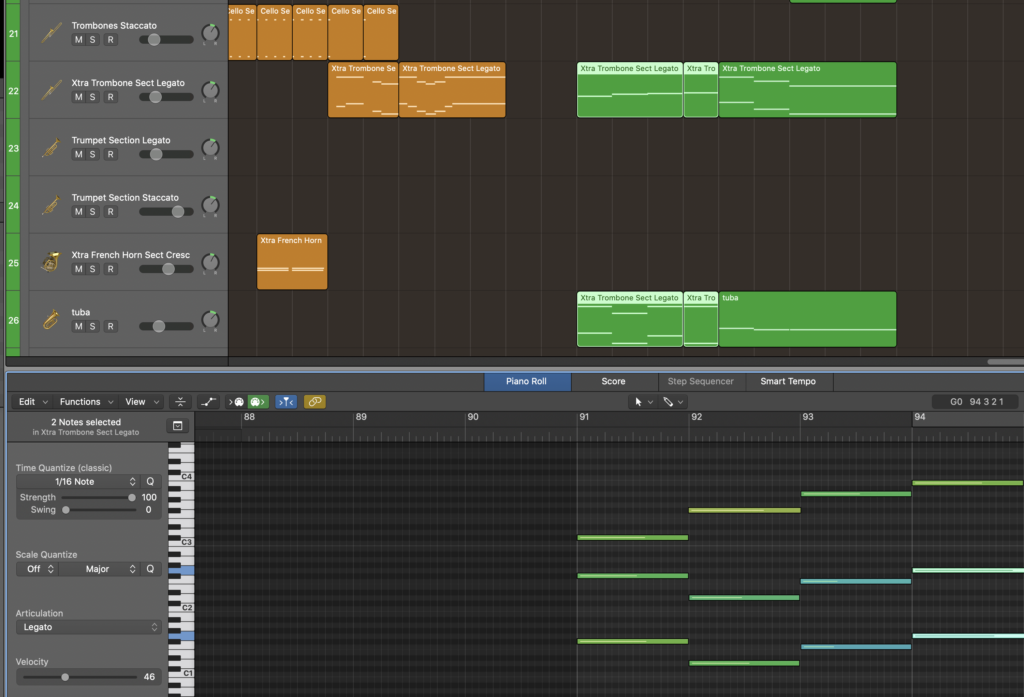
After adding the harp and strings into the arrangement the music was beginning to sound very triumphant, however I decided it would sound even more triumphant if I was to add brass. As the instrumental timbres of brass sound very powerful and victorious. To do this I made the tuba play the bass notes of each chord in the harmonic progression, which gave the harmony a strong harmonic foundation. I learnt that the tuba can be good for this purpose through my own research on instrumental characteristics, which was very useful. The final piece of brass I added was the bass trombone, this instrument moved up by leaping to the fifth of each chord in an ascending pitch. This was successful as it allowed the trombones to build up towards a heroic climax due to its constantly raising pitch and big musical leaps in terms of note intervals. I would have used a trumpet in this instrumental however, due to the very poor quality of Logic’s MIDI trumpet I decided it was best to leave it out of the arrangement. Therefore if I had access to a better brass virtual instrument I would have defiantly added more brass instruments in my project.
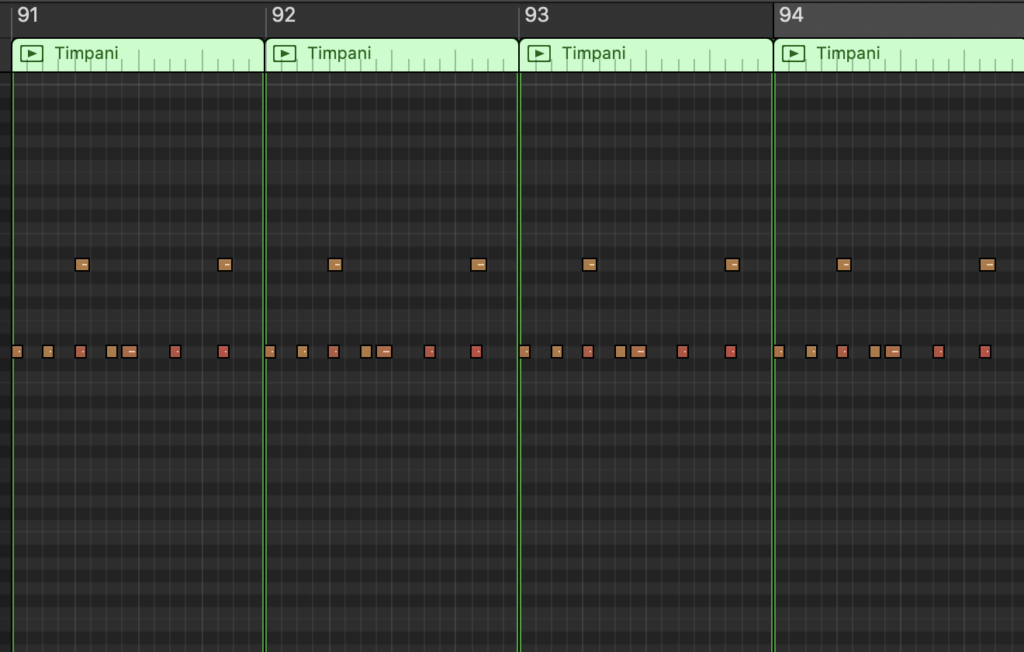
This is the timpani instrumental I composed for the victorious theme in the Wwise Adventure Game scene, as you can see this rhythm repeats every bar which builds up tension within the music as the listener expects the musical rhythm to develop. This would get repetitive after a while, however the triumphant theme does not last long. Therefore the repetitive drum pattern works well with the music and does not get boring for the listener. The rhythm for this drum pattern is exciting as it plays in a fast up-beat rhythm which also complements the staccato string rhythm. I also wanted the the timpani to have a powerful and dominant tone within the music, therefore to do this I used the velocity tool to make the instrument play at a Forte dynamic level. Furthermore making it sound more powerful within the music, providing the music with more energy and intensity. In conclusion writing for the timpani went very well as provided the music with rhythmic energy and helps build up tension in the music towards the climax due to the repetitive loop of the rhythm. If I was to improve this rhythm I would add more percussion into the music such as concert bass drums and taikos to give the music more rhythmic texture, however on Logic there is very limited percussion samples for cinematic music. As most of the samples on Logic for percussion are made up of; drum kits, shakers and latin percussion. Therefore making it hard to compose for percussion, furthermore given a high quality percussion plug-in I would have composed more for the percussion elements of this project.

The final instrument I added into the triumphant theme of the music was a dark choir, I added this instrument into the music to give the music more harmonic texture to furthermore make the music sound more full and energetic. This would furthermore help build up even more anticipation towards the climax of the music. The final creative technique I used on the choir was to use voice leading once again, this was very important to use on the choir as playing block chords can make the choir sound very disjointed and unnatural. Furthermore using voice leading was successful as it made the harmonic transitions blend together very naturally and smoothly. The string and timpani rhythms below the legato choir as create a great contrast in rhythmic energy, which furthermore creates a sense of movement within the music. In summary the triumphant theme was very successful as the harmony and rhythms from the; strings, harp and timpani helped build up excitement in the music, furthermore reflecting on the triumphant theme in the story. However one thing I would improve would be to use more percussion to furthermore create more rhythmic energy and texture within the music.
Plot Twist Theme
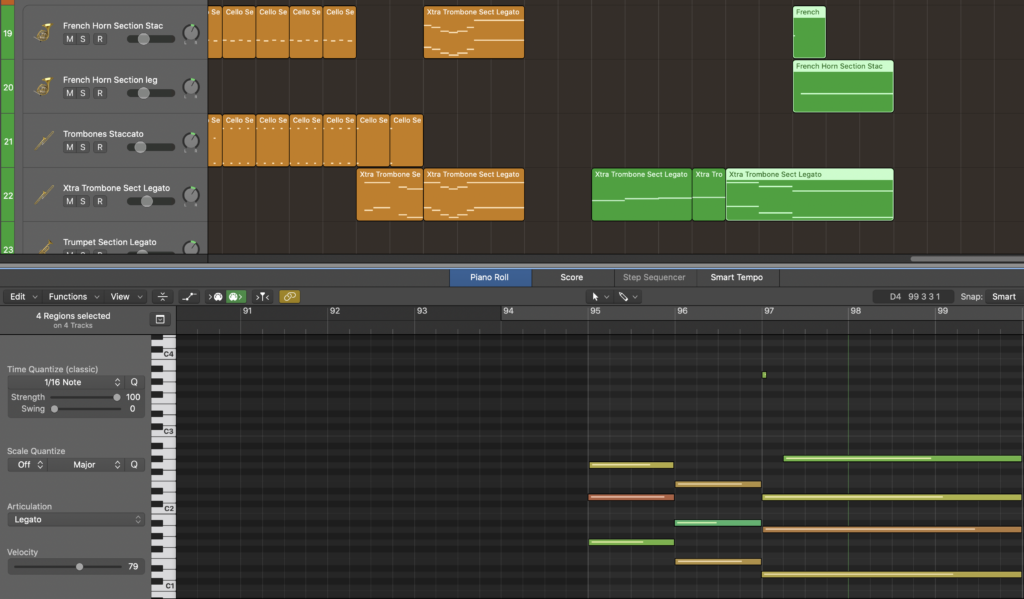
After the music reached the triumphant climax of the music I wanted the music to take a dark and sinister tone, reflecting on the return of the evil monster in the video game. To do this I took the final chord of the triumphant chord progression which was’G’ and turned it into a ‘G minor’, this created a unsettling and dark tone within the music, which made the listener feel shocked as they expected the triumphant music to continue. This reflects on the narrative of the story where the characters think they have been successful, however have failed their task and set the evil free. Therefore this minor key reflects on the emotional distress the characters go through when they realise what they have done. Furthermore this key change was very successful as it captured the distressing narrative of the game very accurately.
The main harmony of this section of music is played by the Tuba and Trombone, which descend in pitch from the chords; G minor, E minor flat 5 and D minor. The deep register of the tuba and bass trombone created a dark and rough texture within the music, which successfully personified the evil presence of the boss on screen. I also chose for these chords to descend in pitch to create a natural resolution on the D minor chord, which brought a satisfying and restful resolution to the end of the composition. In conclusion the brass writing for the plot twist was very successful as the dark timbres accurately represented the presence of the boss, while also bringing a natural conclusion to the end of the composition.
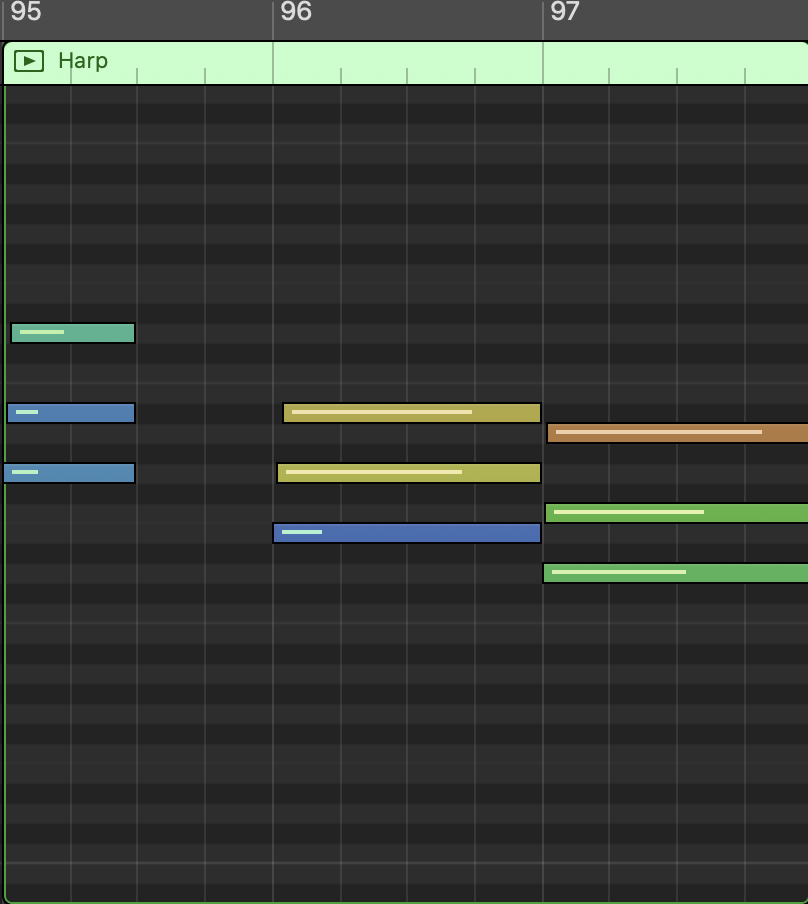
After the plot twist in the music I wanted the momentum and rhythm of the music to slow down to reflect on the despair and failure of the Wizard and Hero in their attempt to vanquish evil. In this section of music I made the harp play strummed out chords following the progression I mentioned before 2 octaves lower than the harps previous arpeggio instrumental. The low register of the harp created a sustained dark and sinister tone within the music, which was made to resemble the evil presence of the boss. Alternatively the lack of rhythm int he harp in this section of music, creates a huge contrast between its previous fast arpeggio rhythm. Furthermore successfully creating a feeling of defeat and failure within the music, reflecting on the narrative of the video games story.
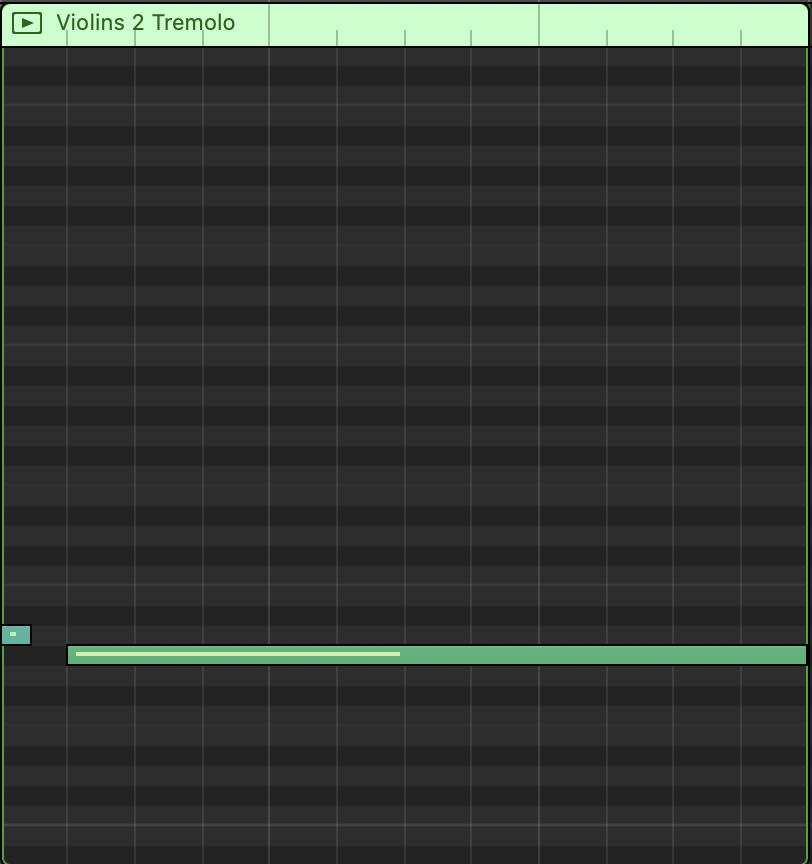
To add a little bit of detail into the music I added a cello tremolo which goes from playing a grace note on A to then resolving on G# which created a dissonant and clashing tone within the D major chord, furthermore reflecting on the evil and dangerous entity on screen. Furthermore the unsteady tone of the tremolo creates a sense of danger within the music and unpredictability in the music, making the player wonder what is going to happen next. I did this as the game ends on a cliff hanger, and it seemed fitting to make the music end on a moment of tension within the music. Therefore this tremolo was a very slight detail in the music, which however was very successful in holding tension within the music and reflecting on the presence of evil in the video game.
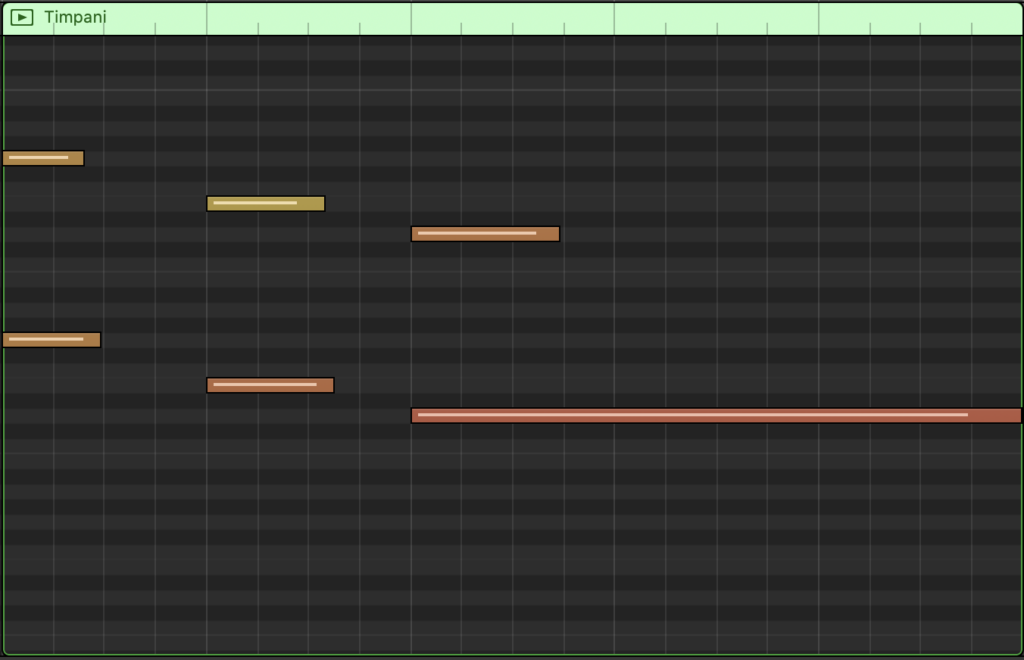
This image shows the arrangement I made for the timpani when the music transitions into the minor key. For the timpani I wanted to create a dramatic and grand conclusion to the music using powerful and loud accented hits, I did this by making the timpani play on each beat of the chord transition. This made the music sound like it was all moving at once, furthermore successfully giving the music a dramatic and powerful conclusion.
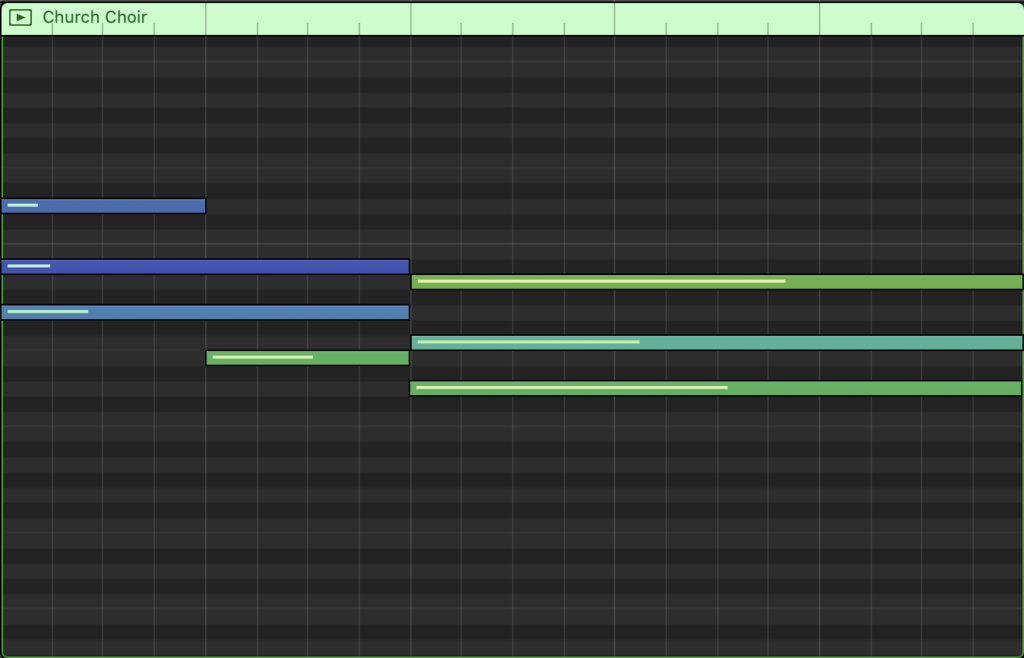
This is now the final piece of my musical arrangement I added to my college project, which is once again the dark choir plug-in. This instrument is following the chord progression after the key change which is; G minor, E minor b5 and D minor. I used this instrument as the music would sound very empty when not using this instrument after using it in the triumphant theme, as the timbre of this instrument is very distinctive in the music. When composing for this instrument I once again used voice leading to blend the chord changes together. The dark choir was very successful in the end of the composition as it successfully blended the chord transitions together while adding a bed of harmonic texture to the music, furthermore making the arrangement sound full and alive.
Mixing
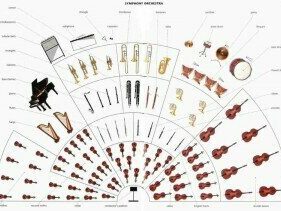
After I finished arranging my project I decided to get to mixing straight away in order to create a clear mix in time for the final showcase. I started mixing my music by panning each of my instruments out to give the music a sense of space within the music. When staring to pan I looked at this image of an orchestral arrangement in real life for reference when panning my instruments, I did this to create a realistic soundscape of an orchestra in my music. One mistake I made when initially panning my instruments was assigning the panning space from the perspective of the conductor, for example I panned the double basses the very far right of the stereo-field as this is where it is located on the graph. This made the music sound very unbalanced, after receiving feedback from my tutor I learned that I must pan my instruments from the perspective of the audience. Therefore meaning the bass should only by panned +10-15 degrees instead of +50. Panning my music was very successful in the end as it made my music sound much immersive and lifelike, due to the instruments resembling the positioning of a real orchestra.
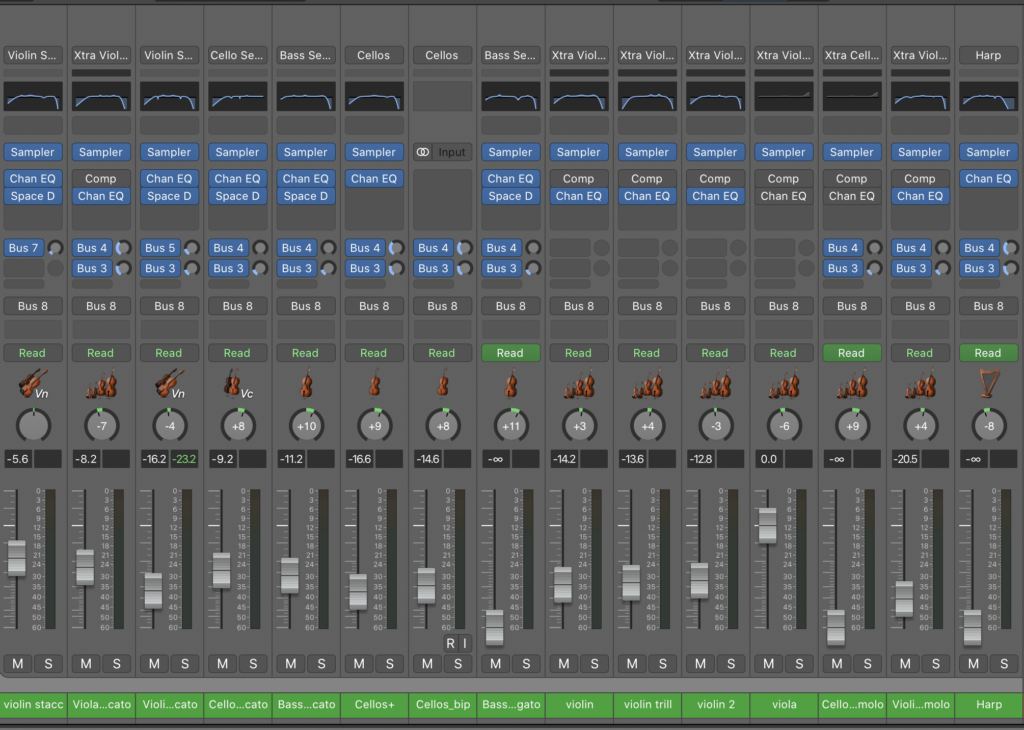
After panning my instruments I decided to continue mixing my track by assigning the different tracks with EQ, this would help bring clarity and character into the different instruments within the final mix of my music. When mixing my strings and brass I followed the guide lines that my research taught my to help me make a professional and clear mix. For the high strings I made a cut around 2.5kHz to get rid of the harsh frequencies in the strings that may have strained the listeners ears, I also made a low cut to avoid creating a mess of bass frequencies and leave space for the double bass. I also made a slight boost in the middle range of the violin and viola to give the instruments more clarity, dominance and instrumental character within the mix. In conclusion mixing for the high strings went very well, as I initially feared my mixing techniques would make the strings sound distant and messy due to my lack of experience in mixing orchestral instruments. However I was not done mixing yet as I still had to EQ the low strings, brass, vocals and stinger before moving onto dynamic levelling.
When mixing the low strings such as the cello and bass it was very important to make a low cut around below 80Hz, as this frequency range produced a lot of muddy frequencies which crowded up the mix in the more intense action themes. On the bass I made a tiny cut in the higher frequency range to cut out scratchy and harmonics which stood out in the mix. In terms of boosting frequencies I gave the cello and bass a frequency boost around 7kHz to give the instruments a sense of clarity in the mix. These techniques were suggested by my research on mixing orchestral instruments, this worked very well as the low strings at the start had a lot of scratchy and muddy frequencies which created a messy and crowded mix. However after following the EQ guidelines the cello and bass had more presence and clarity within the music.
The final instrumental family I Equalised was the brass still following the guidelines of my research I made a small cut around 3kHz, which helped remove the sharp and raspy harmonics from the bass trombone and french horn. Furthermore creating a more clean and organised mix. A side from this cut in the brass I did not do much more EQ on the brass as I did not want to take away any power or dominance away from them in the music. However I did make a boost around 3kHz to give the brass more presence in the mix after the previous cut. In conclusion I did not do too much EQ for the brass as I am very inexperienced in mixing for this area and was scared to ruin the sound of the trombone and french horn in the music, however I could have avoided this scenario by doing more in depth research into brass equalisation. Which would then make me more confident in my mixing skills. A side from this detail the mixing for the brass did help my mix as it took away the high and sharp harmonics that were present in the bass trombone, therefore it was successful but given more research it could have sounded a lot better.
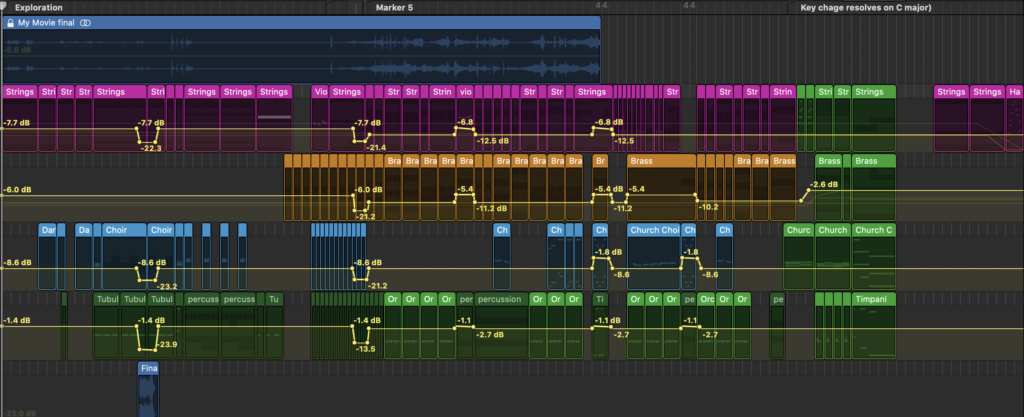
After I was done assigning the EQ the next issue in my mix, which I addressed last week was that the dialogue and sound effects within the game could not be heard beneath the volume of the music. To fix this issue I balanced the levels of all the instruments so that every instrument could be heard within the mix, and the dialogue was heard. For more detail on this process I initially balanced the levels of all the instrumental groups such as; strings, brass, percussion and vocals. This is because once all of these level instruments are balanced, it would only take turning down the master volume of the instrument groups to make sure the dialogue was heard. Balancing the levels was very successful as it was very clear to hear the music and the dialogue within the game, furthermore providing a more relaxed and pleasurable viewing experience for the listener/player. However there were moments in the track when the levels of the music mixed with other sound effects and dialogue that needed dynamic automation. One example of this was the stinger, as the music playing underneath this stinger sounded very messy and muddy within the mix, due to the two instrumental tracks playing at once. To solve this issue I used dynamic automation on all the group headings; brass, strings, choir and percussion to effectively turn down the volume of the whole track when this stinger was playing. This was very effective as the stinger was much more clear to hear once the music was turned down, furthermore making the mix sound much more clean for the player. One another scenario where I used dynamic automation was during the Wizards dialogue in the boss fight, the music despite being levelled had some much texture it was difficult to hear the Wizard due to the large amount of variated frequencies. Therefore to fix this issue I once again turned down the volume of all the tracks to make the dialogue clearer to hear, this was once again very successful as it allowed the player/viewer to understand what the Wizard is saying in context with the story of the game. Another example of me automating the music was in the transition block for the boss fight, as this piece of music was designed to highlight an important moment within the game. Therefore I decided it was very important that the music had to be louder in order to highlight this significance, therefore to do this I turned up the dB of the track by around 3dB.
After I was done mixing my track I was done with producing and composing my own music for this project, below you can see the final product of my work.
Mixing Summary
In conclusion mixing my track was very successful as it provided a cleaner and more clear mix for the player to enjoy playing through the level to, the most successful part of the mixing process was volume balancing as this allowed the video game dialogue to be clearly heard beneath the video game dialogue. Another successful part of my mixing process was panning the instruments as this gave the track a sense of space, which furthermore made the music sound more life like and realistic due to it resembling a real orchestral arrangement. However my weakest point in my mixing process was assigning the EQ to the different instruments as I am not confident in my decisions when doing this, hence why I was using a strict guideline. Furthermore in the future I would like to improve from this mistake by practicing independently with mixing my own tracks and online stems, I will also do more extensive research into mixing strings before mixing future projects. However this is my last project at college, therefore I will have to learn to mix music outside of college and in my own free time outside of education. However knowing how to independently mix your own music is a very useful tip in the music industry, therefore learning how to do this would help me obtain a career in the music industry.
By the time I finished my mix I sent it off for mixing in time for the showcase, therefore I didn’t have anymore time to improve the mix in my music. However there are many things I would improve if I had the time, the main thing I would improve would be to add reverb. This is because the lack of reverb on some places in the music, especially the final chord meant that the music cut off and ended very abruptly. Therefore if I was to do this again I would add reverb to some instruments such as the brass to make the music flow more naturally. One other weakness to my mix/arrangement was the stinger, as due to it being bounce into the music I was very limited in my mixing capabilities on this track. This was due to all the brass and percussion being compressed to one track, this furthermore made the stinger sound very compressed in the music. Furthermore if I was to do this again instead of bouncing the whole stinger to one track I would bounce it into stems, this would give me more freedom to EQ each individual track in the stinger. Furthermore allowing me give the stinger more space within the mix. It is worth mentioning that I initially planned on adding compression, however due to all the tracks being mixed in MIDI there was no need for this in my mix. Therefore I did not end up compressing my track when mixing the instruments.
Source List
Interlude, 2018. Why Is the Orchestra Seated That Way? An Explanation. [image] Available at: <https://interlude.hk/orchestra-seated-way-explanation/> [Accessed 25 May 2022].
MindTools, n.d. Gibbs Reflection Cycle. [image] Available at: <https://www.mindtools.com/pages/article/reflective-cycle.htm> [Accessed 26 May 2022].